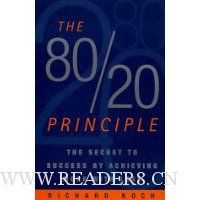| 商家名称 | 信用等级 | 购买信息 | 订购本书 |
 |
The 80/20 Principle: The Secret to Achieving More with Less |  |
|
 |
The 80/20 Principle: The Secret to Achieving More with Less |  |

Now in 1998, Richard Koch takes a fresh look at the 80/20 principle and finds that the basic imbalance observed by Pareto 100 years ago can be found in almost every aspect of modern life. Whether you''re investing in stocks, analyzing company sales, or looking at the performance of a Web site, you''ll find that it''s usually 20 percent that produces 80 percent of the total result. This means 80 percent of what you do may not count for much. Koch helps you to identify that 20 percent and shows you how you can get more out of your business, and life, for less. --This text refers to an out of print or unavailable edition of this title.
From Booklist
The Pareto Principle--in Koch''s words, "a minority of causes, inputs, or effort usually lead [s] to a majority of the results, outputs, or rewards" --is hardly new; Vilfredo Pareto discovered it in 1897. But London-based investor, entrepreneur, and author Koch traces Pareto''s insight through the past century (George K. Zipf, Joseph M. Juran, IBM and other computer firms) and adds a bit of chaos theory to make the 80/20 principle a way of life. He spells out essential characteristics of "80/20 analysis" and "80/20 thinking," then explores application of this "Vital Few" approach, first in business, then in achieving personal success and happiness. Koch closes with a chapter on the social implications of the Pareto Principle, urging that this predictable imbalance between inputs and outputs is "not inherently right wing," and that steps such as spreading best practices in education to all students and giving those currently excluded from the market economy a stake in the game would generate less inequality as well as greater productivity. Mary Carroll --This text refers to an out of print or unavailable edition of this title.
Review
From The 80/20 Principle:
"The 80/20 Principle can and should be used by every intelligent person in their daily life...It can multiply the profitability of corporations and the effectiveness of any organization. It even holds the key to raising the quality and quantity of public services while cutting their cost... The 80/20 Principle asserts that a minority of causes, inputs, or effort usually lead to a majority of the results, outputs, or rewards. Taken literally, for example, 80 percent of what you achieve in your job comes from 20 percent of the time spent. Thus for all practical purposes, four fifths of the effort--a dominant part of it--is largely irrelevant."
To learn how you can tap the hidden potential of the 80/20 principle in your life, read Richard Koch''s exciting new book.
From the Hardcover edition.
Review
From The 80/20 Principle:
"The 80/20 Principle can and should be used by every intelligent person in their daily life...It can multiply the profitability of corporations and the effectiveness of any organization. It even holds the key to raising the quality and quantity of public services while cutting their cost... The 80/20 Principle asserts that a minority of causes, inputs, or effort usually lead to a majority of the results, outputs, or rewards. Taken literally, for example, 80 percent of what you achieve in your job comes from 20 percent of the time spent. Thus for all practical purposes, four fifths of the effort--a dominant part of it--is largely irrelevant."
To learn how you can tap the hidden potential of the 80/20 principle in your life, read Richard Koch''s exciting new book.
From the Hardcover edition.